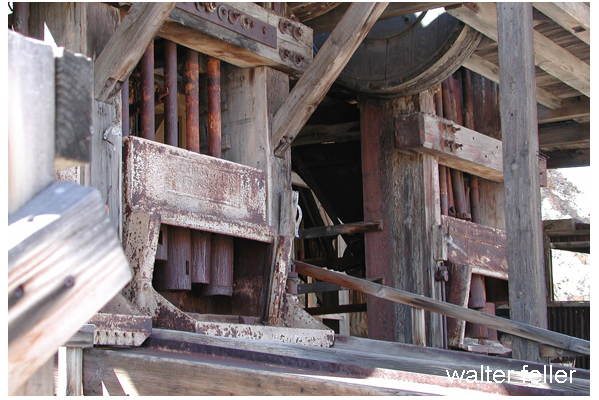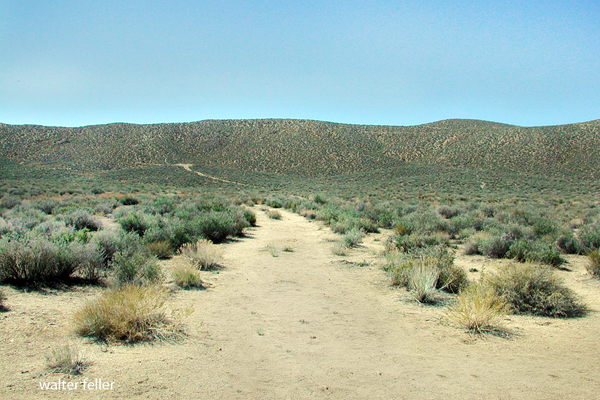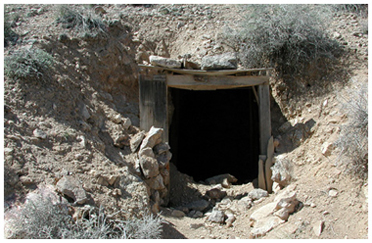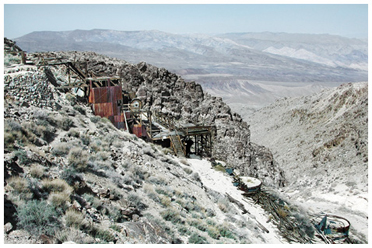History of Skidoo

In early 1906, two prospectors—John Ramsey and “One-Eye” Thompson—got caught in a fog near Emigrant Spring while heading toward the gold strike at Harrisburg. When the skies cleared, they noticed gold-colored ledges and quietly staked claims. Soon after, Bob Montgomery purchased the group, known as the Gold Eagle claims, and planned development with a quartz mill.
Water, however, was a problem. The nearest spring couldn't meet demand, so they undertook a bold engineering project: building an 18-mile gravity-fed pipeline from Birch Spring near Telescope Peak to Skidoo. Finished in November 1907, the pipeline cost $250,000 and fell 1,800 feet in elevation, providing enough force to power the mill.
By March 1907, Skidoo had 400–500 residents, complete with stores, saloons, restaurants, a doctor, lawyers, and even a phone line to Rhyolite. The town sat at 5,600 feet, allowing for summer production. By April, 130 buildings had sprung up. Skidoo applied for a post office and planned stage and auto lines from Beatty. No one knows for sure how the town got its name—speculations include 23 claims filed, the 23rd of January, 23 men involved, or the 22-mile pipeline (rounded to 23).
The financial panic of 1907 slowed expansion. Delays in milling and limited resources caused mining to decline. Although activity rose and fell over the next several years, the rich ore was mostly exhausted by September 1917. By 1922, only one resident—Old Tom Adams—remained. In 1923, Skidoo had a final moment of fame as a filming location for Greed, the first major motion picture shot in Death Valley.
Skidoo was one of the last significant gold mining camps in the region, known especially for its narrow vein mining and the impressive engineering of its water pipeline.
Harrisburg

* By July 4, 1906, the town seemed assured of success. Plans had already been made for an auto line from Beatty, a stage line seemed definite, application had been made for a post office and with its high altitude (5600 ft.) production could continue all summer. By the end of August 1906 a townsite had been marked out. No one will ever know exactly how the town got its name, 23 Skidoo. Possibilities include the 23 mile water line (which is actually 22 miles long), the 23 claims initially flied, the location of the claim on the 23rd of January, and the 23 men who founded the town.
By March of 1907, Skidoo boasted 400-500 citizens and had stores offering mining equipment, hardware, clothing, dry goods and groceries. There were saloons, a newspaper, restaurants, a physician, and lawyers. By April the town had 130 homes and businesses of frame, wood and iron. A phone line had been completed to Rhyolite, permitting outside communication. In November 1907, the pipeline was finally completed and water flowed into Skidoo. Final tally on the cost was $250,000. The financial panic of 1907 affected the town by reducing plans for additional businesses. By the fall of 1908 mining activity had slowed tremendously in Skidoo due to the scarcity of mills in the area.
Mining activity ebbed and flowed over the next several years and in September 1917, the rich vein was played out and the mine closed down for the last time. By 1922 several buildings were still standing along one street and an old prospector "Old Tom Adams" was the lone citizen. In 1923 Skidoo was one of the location sites for the Hollywood film, "Greed" which was the first feature film made in the Death Valley area.
Skidoo was one of the last gold mining camps in Death Valley. One of the unique features of the mining operation in Skidoo was the mining of large amounts of gold ore by going into narrow ore veins using large-scale mining efforts. The pipeline to Skidoo is considered to be a marvelous feat of engineering. It crossed from Skidoo over Harrisburg Flats and Wood, Nemo, and Wildrose Canyons to the Telescope Peak area.
Skidoo Mill
Skidoo Mill Photo Gallery
Death Valley
Historic Resource Study
SECTION III: INVENTORY OF HISTORICAL RESOURCES THE WEST SIDE

Mine tunnel

Skidoo mill
Timeline
January 1906 – John Ramsey and John “One-Eye” Thompson discover gold near Emigrant Spring during a fog delay en route to Harrisburg.Spring 1906 – Bob Montgomery purchases their claims, naming them the Gold Eagle group, and begins planning a milling operation.
July 4, 1906 – Town development begins; Skidoo's success seems promising with transport plans, post office application, and townsite mapping.
August 1906 – Townsite officially marked out. The origin of the name "23 Skidoo" remains uncertain, with several theories tied to the number 23.
March 1907 – Population reaches 400–500. Businesses, homes, and services are well-established. A telephone line connects Skidoo to Rhyolite.
April 1907 – Town includes 130 buildings made of frame, wood, and iron.
November 1907 – Completion of the 23-mile gravity-fed water pipeline from Birch Spring to Skidoo. Final cost: $250,000.
Late 1907 – Financial panic slows development and investment in the town.
Fall 1908 – Mining activity declines due to limited milling capacity in the area.
1909–1917 – Mining continues intermittently with reduced activity.
September 1917 – The main vein of ore is exhausted; Skidoo mine shuts down permanently.
1922 – Only a few buildings remain; "Old Tom Adams" is the town’s last known resident.
1923 – Skidoo is used as a filming location for Greed, the first feature film shot in Death Valley.
The Hanging of Hootch Simpson (1908)
Skidoo’s most infamous moment came not from gold but from vigilante justice. In April 1908, the town’s saloon keeper, Joseph “Hootch” Simpson, murdered Jim Arnold, a well-liked banker who handled payroll for the Skidoo mines. Simpson, reportedly deep in debt and often drunk, knew when Arnold would be carrying a large sum of money and ambushed him outside town. Arnold was found dead shortly after, and suspicion immediately fell on Simpson.Citizens arrested him and locked him up in the small jail. But justice in Skidoo moved fast—and rough. That night, a mob broke into the jail, dragged Simpson to a telephone pole near the mill, and hanged him. Most strikingly, a photographer documented the lynching, making it one of the few photographed executions by mob in U.S. history.
Simpson’s body was buried far from the town cemetery, a final mark of disgrace. The event shocked even the rough-edged mining camp and cast a long shadow over Skidoo’s brief boomtown glow.
Reference: Lingenfelter, Richard E. Death Valley and the Amargosa: A Land of Illusion. Berkeley: University of California Press, 1986. pp. 374–376.